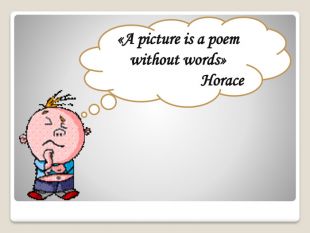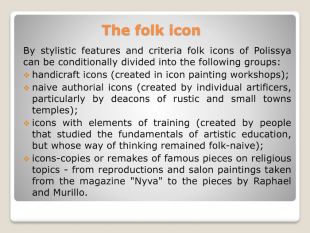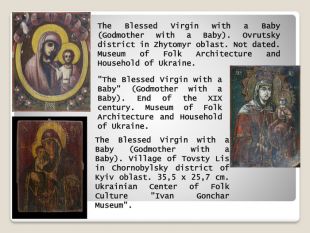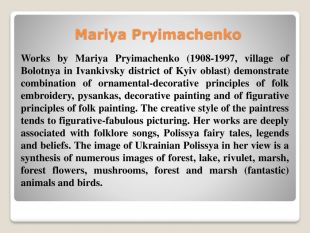Презентація :"Folk painting "
The task of presentation is to inform the pupils that folk painting of Polissya is one of the important components of spiritual culture of this land. The phenomena of painting gives an opportunity to penetrate into the context of its extra-plot and extra-thematic connections, to determine more exactly its ritual-magical and social-utilitarian functions.
It tells about the main representatives of folk painting of Polissya and their works.

































Folk painting of Polissya is one of the important components of spiritual culture of this land. Conceptualization of painting as an imitative part of the integral ceremonial-folklore whole, semiotic approach to the phenomena of painting give an opportunity to penetrate into the context of its extra-plot and extra-thematic connections, to determine more exactly its ritual-magical and social-utilitarian functions. However, the study of folk painting of Polissya, particularly of icon painting and folk picture, still requires much effort, because folk icon painting has not yet been a subject of systematic collecting and studying and in the XVIII-XIX centuries suffered persecutions from official church circles. During all the years of Soviet governance folk icon and picture were not studied and in specific periods were even prohibited and destroyed. Besides, the actual state of things with collecting and studying of imitative folklore of Polissya, comparing to that of Middle Naddnipryanshchyna, Podillya, Prykarpattya, is considerably worse and more complicated. Exactly for that reason the quantity of folk icons and pictures of Polissya held in museums as well as in private collections is considerably smaller than that of works from other regions. There are several reasons for that to be named, the most important among which in our opinion is archaism of folklore of Polissya that on the one hand promotes conservation of ancient pre-Christian folklore-ceremonial traditions, and on the other hand - straitens and retards penetration and variational production of new iconographical factors, particularly icons. The lack of abundance and diversity of depictive material in the villages of Polissya was remarked upon by researchers, which visited the villages of Poltava land, Kyiv land, Podillya.
The folk icon. By stylistic features and criteria folk icons of Polissya can be conditionally divided into the following groups: handicraft icons (created in icon painting workshops); naive authorial icons (created by individual artificers, particularly by deacons of rustic and small towns temples);icons with elements of training (created by people that studied the fundamentals of artistic education, but whose way of thinking remained folk-naive); icons-copies or remakes of famous pieces on religious topics - from reproductions and salon paintings taken from the magazine "Nyva" to the pieces by Raphael and Murillo.
The most popular folk icons are: St. Nicholas. Village of Tovsty Lis in Chornobylsky district. Approximately 2nd half of the XIX century. 39,8 х 29,8 cm. Ukrainian Center of Folk Culture "Ivan Gonchar Museum". "St. Nicholas". Chernigiv oblast. Town of Ichnya. Museum of Folk Architecture and Household of Ukraine.
The Blessed Virgin with a Baby (Godmother with a Baby). Ovrutsky district in Zhytomyr oblast. Not dated. Museum of Folk Architecture and Household of Ukraine."The Blessed Virgin with a Baby" (Godmother with a Baby). End of the XIX century. Museum of Folk Architecture and Household of Ukraine. The Blessed Virgin with a Baby (Godmother with a Baby). Village of Tovsty Lis in Chornobylsky district of Kyiv oblast. 35,5 х 25,7 cm. Ukrainian Center of Folk Culture "Ivan Gonchar Museum".
Folk icon synthesizes historical, everyday-productive and spiritual experience of the people, mirrors its tastes and preferences, moral and ethical principles. Folk icon, including that of Polissya, is a unique phenomenon of our art. The Christian religious factor exists in it in a folklore-influenced way, while the folklore factor enriches itself with the centuries-old experience of Christian morality.
Ukrainian folk picture. Ukrainian folk pictures created in the XVIII - ХХ centuries by painters-craftsmen (made to order), by handicraftsmen (for sale; the so-called "market" picture) and by naive artificers-authors (for themselves, for acquaintances, for exhibitions) in Polissya, are collected and placed on record least of all.
For example, the oldest genre-subject of folk picture "Mamay the Cossack" is currently represented only by three examplars in Chernigiv Arts Museum. One of them came in 1952 from the Kyiv Historical Museum, another one - from the collection of G. Galan. However, before the war of 1941-1945 in Chernigiv land the collection by V. Таrnovsky had six more "Mamays", which were lost during the violent events of those years. Such pictures, as a rule, were made to order. The character of a Cossack - bandura-player is not that of a picture but rather an icon-figurative, cosmological one. As for the "Mamays" from Chernigiv land, the place of creation of each of them up to the present time has not been determined. However, the presence of this picture on the territory of Polissya is undoubtedly an important cultural achievement of this land.
Most of folk pictures - both those collected in the Chernigiv Arts Museum and those remaining in country houses, on the territory of Polissya are either interpretations-copies (quite often also free remakes) of reproductions (postcards, magazine and book illustrations) of works by famous painters - T. Shevchenko ("The Court"), V. А. Tropinin ("Ustym Karmalyuk"), І.І. Sokolov ("Scytheman's Farewell"), К. О. Тrutovsky ("On Monday after the Wedding"), М. Pimonenko ("At the Ford"), or works bought at a fair. Among the latter none of the so-called canonical variatively repeating fables has been found. Landscapes with houses, water, forest, a hunter in a boat (their technique - oil at canvas or veneer) mostly lack either fabulous or iconographical entity, but have something in common in color and coloristic presentation. As for folk still lives, the search in the funds of museums, in field materials by M. Matiychuk have not given a chance to find any common iconographical traditional basis. No traditional folk pictures "Kateryna" (after T. G. Shevchenko), "Natalka and Petro" and "Elope, Petro with Natalka…" (after I. P. Kotlyarevsky), and also "A Cossack and a Girl at a Well", "An Angel Looks after Children…" have been found in Polissya as well.
Among the so-called amateur folk painting first of all the works by Trokhym Chervatyuk (born in 1902) from Zhytomyr should be named. He is a typical "naive" painter of the genre-ethnographic kind. In his paintings dedicated to Polissya countryside of the olden times ("An Evening of a Family in Polissya" ,"Polissya Technique" etc.) the interior of country houses is documentary and realistically represented, objects of household, tools of hand-labor are scrupulously "named". T. Chervatyuk has also created many works upon war themes - the civil war and the World War II. Still the most artistically valuable are his ethnographic works, in which a certain influence of cheap popular prints of the XVIII-XIX centuries and works by painters-peredvizhnyks can be found."An Evening of a Family in Polissya" "Polissya Technique"
Kostyantyn Lyashenko, a painter-amateur (born in 1916 in Chernigiv land, in the 1990-ties lived in the village of Bratske of Mykolayiv oblast) in his works continues and develops the traditions of folk picture of the 1920-1930-ties. Most of the works by the painter reconstruct the nostalgic-lyrical image of Polissya countryside of the olden times ("Wheat of Gold", 1976; "The Home", beginning of the 1980-ties ; "Storks", 1980; "Morning" , 1974 and others). In these works the stereotypes of "market" folk picture (smoke-pink sky at the west, "fuzzy" silhouettes of trees) are subtilized by prominent painting-coloristic talent of the author. The pictures are featured by somewhat cool pink-pearl color palette. In the pieces representing flowers and women notable is the influence of stylistics of Kateryna Bilokur."The Home""Amidst the Flowers"
The paintings by Pylyp Zakharchuk from Zhytomyr by many features are most close to folk picture and at the same time to the so-called folksy realism (M. Pymonenko, S. Vasylkivsky, I. Yizhakevych). The painter glorifies, somewhat idealizing a la "calm willows" and "native forts", the past of summer-favored hamlet Ukraine. Scenes of meetings of kempt girls in embroidered shirts and nice boys in straw hats and folk trousers are full of idyllic admiration. However, the pictures are surely and well-written, the source of power and life realism in them is the penetrating image of the generous Ukrainian nature - green masses of trees with powerful trunks full of vegetative power, vigorous hills poured with the gold of ripe corns. The picture by P. Zakharchyk "A Cossack and a Girl at a Well" (the only one seen in Polissya) represents the scene of the meeting in a somewhat archaic way and in such a way reminds of folk picture of the 1920-ties - 1930-ties. "A Cossack and a Girl at a Well""A Meeting in a Field"
Stanislav Sartsevych (1904-1987) from Lutsk is a sculptor and painter, the author of "naive" sculptures of cement, painted with oil paints. He is also the author of a series of painted works a la "market" picture, in which, however, the kitsch effects of the latter are edged out by real painting and gracious coloristics. Among the "painted" sculptures ladies in hats, bathers, angels, portraits of I. Franko, M. Gogol, V. Stefanyk are worth most attention; among the pictures - "The City and the Cultural Center" , "A Walking Lady", "A Landscape with a River" painted on the walls of the painter's house. Their palette is close to the palette of Polissya "market" landscapes."The City and the Cultural Center" (oil)A fragment of mural painting in the house-workshop
Ukrainian folk decorative paintings. Folk decorative paintings (pysankas, painted wedding chests - "skrynyas", toys and other wood products) with regard to their color-formal aspects may be classified with painting. A great amount of pysankas almost from all areas of Polissya were collected as far back as in the ХІХ century for the Lubensky Museum of Ye. N. Skarzhynska and were represented in the book by S. К. Kulzhynsky (color and black-and-white tables). Pysankas of Chernigiv land and the present Sumy land (Glukhivsky, Novgorod-Siversky, Krolevetsky, Starodubsky districts) are given by Pelageya Lytvynova in albums "South-Russian ornament. Issue 1." (1899) and "South-Russian folk ornament. Issue 2" (1902).
The ornament of Polissya's pysankas generally is of a floral-geometrical kind. Their motifs are not so structured and fine as that of pysankas of the Carpathians and Prykarpattya, and at the same time not so floral-decorative as that of Poltava land and south regions. Geometric character and constructibility of their ornaments is reached by way of geometrization of floral forms, which acquire a compact and expressive look. As for this and also for the favored colors, among which red, black and white are preferred, pysankas of Polissya to some extent resemble pysankas of Podillya. The main motifs are - "vason", "full mallow", "rakes", "locks", "pancakes", "windmills", "curves". Motifs "vason", "bouquet", "grapes", "flower", "apple" are most widespread with painted wedding chests and wooden plates, in particular, in Chernigiv land. In Volyn and other areas of Polissya painted chests are quite rare. Not so long ago - in the 1980-ties - wood covers of low wells in Volyn were painted with crosses, flowers, circles and twisty bines.
Mariya Pryimachenko. Works by Mariya Pryimachenko (1908-1997, village of Bolotnya in Ivankivsky district of Kyiv oblast) demonstrate combination of ornamental-decorative principles of folk embroidery, pysankas, decorative painting and of figurative principles of folk painting. The creative style of the paintress tends to figurative-fabulous picturing. Her works are deeply associated with folklore songs, Polissya fairy tales, legends and beliefs. The image of Ukrainian Polissya in her view is a synthesis of numerous images of forest, lake, rivulet, marsh, forest flowers, mushrooms, forest and marsh (fantastic) animals and birds.
Folklore-ornamental way of artistic thinking of M. Pryimachenko influences first of all the spatial character of her works. While in works by K. Bilokur space is semantically stratified, in works by M. Pryimachenko it is personified in images. Her figurative-fabulous works, as a rule, are divided into three spatial dimensions, symbolizing sky, earth and water, and people and animals are fitted into these dimensions under the rules of the so-called hierarchical perspective. The poetics of Ukrainian folk painting is one of figurative aspects in works by the paintress. Most often she addressed herself to the theme of meeting of a Cossack with a girl at a well and created numerous variants, in which she described the scene of the meeting not on the genre-family but on the totem-tribal plan. Works by Mariya Pryimachenko are a cultural phenomenon not only of Ukrainian, but also of international value.
-
 Кравцов Ігор 08.11.2023 в 06:43Загальна:5.0Структурованість5.0Оригінальність викладу5.0Відповідність темі5.0
Кравцов Ігор 08.11.2023 в 06:43Загальна:5.0Структурованість5.0Оригінальність викладу5.0Відповідність темі5.0


про публікацію авторської розробки
Додати розробку

































